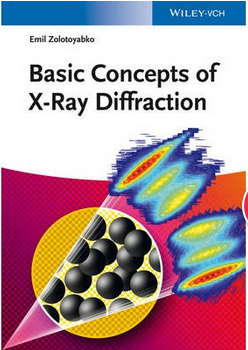
Basic Concepts of X-Ray Diffraction
[BOOK DESCRIPTION]
Authored by a university professor deeply involved in X-ray diffraction-related research, this textbook is based on his lectures given during more than 20 years for graduate students. It adopts a well-balanced approach, describing basic concepts and experimental techniques, which make X-ray diffraction an unsurpassed method for studying the structure of materials. Both dynamical and kinematic X-ray diffraction is considered from a unified viewpoint, in which the dynamical diffraction in single-scattering approximation serves as a bridge between these two parts. The text emphasizes the fundamental laws that govern the interaction of X-rays with matter, but also covers in detail classical and modern applications, e.g., line broadening, texture and strain/stress analyses, X-ray mapping in reciprocal space, high-resolution X-ray diffraction in the spatial and wave vector domains, X-ray focusing, inelastic and time-resolved X-ray scattering.This unique scope, in combination with otherwise hard-to-find information on analytic expressions for simulating X-ray diffraction profiles in thin-film heterostructures, X-ray interaction with phonons, coherent scattering of Mossbauer radiation, and energy-variable X-ray diffraction, makes the book indispensable for any serious user of X-ray diffraction techniques. Compact and self-contained, this textbook is suitable for students taking X-ray diffraction courses towards specialization in materials science, physics, chemistry, or biology. Numerous clear-cut illustrations, an easy-to-read style of writing, as well as rather short, easily digestible chapters all facilitate comprehension.
[TABLE OF CONTENTS]
Preface xi
Introduction 1 (4)
1 Diffraction Phenomena in Optics 5 (6)
2 Wave Propagation in Periodic Media 11 (10)
3 Dynamical Diffraction of Particles and 21 (24)
Fields: General Considerations
3.1 The Two-Beam Approximation 23 (10)
3.2 Diffraction Profile: The Laue 33 (5)
Scattering Geometry
3.3 Diffraction Profile: The Bragg 38 (7)
Scattering Geometry
4 Dynamical X-Ray Diffraction: The 45 (16)
Ewald--Laue Approach
4.1 Dynamical X-Ray Diffraction: Two-Beam 49 (12)
Approximation
4.1.1 The Role of X-Ray Polarization 50 (2)
4.1.2 The Two-Branch Isoenergetic 52 (4)
Dispersion Surface for X-Rays
4.1.3 Isoenergetic Dispersion Surface 56 (5)
for Asymmetric Reflection
5 Dynamical Diffraction: The Darwin Approach 61 (16)
5.1 Scattering by a Single Electron 61 (3)
5.2 Atomic Scattering Factor 64 (2)
5.3 Structure Factor 66 (2)
5.4 Scattering Amplitude from an 68 (3)
Individual Atomic Plane
5.5 Diffraction Intensity in the Bragg 71 (6)
Scattering Geometry
6 Dynamical Diffraction in Nonhomogeneous 77 (14)
Media: The Takagi--Taupin Approach
6.1 Takagi Equations 77 (7)
6.2 Taupin Equation 84 (7)
6.2.1 Taupin Equation: The Symmetric 84 (2)
Laue Case
6.2.2 Taupin Equation: The Symmetric 86 (2)
Bragg Case
6.2.3 Solution of the Taupin Equation 88 (3)
for Multilayered Structures
7 X-Ray Absorption 91 (6)
8 Dynamical Diffraction in 97 (24)
Single-Scattering Approximation: Simulation
of High-Resolution X-Ray Diffraction in
Heterostructures and Multilayers
8.1 Direct Wave Summation Method 103(18)
9 Reciprocal Space Mapping and Strain 121(10)
Measurements in Heterostructures
10 X-Ray Diffraction in Kinematic 131(8)
Approximation
10.1 X-Ray Polarization Factor 133(2)
10.2 Debye--Waller Factor 135(4)
11 X-Ray Diffraction from Polycrystalline 139(6)
Materials
11.1 Ideal Mosaic Crystal 139(2)
11.2 Powder Diffraction 141(4)
12 Applications to Materials Science: 145(10)
Structure Analysis
13 Applications to Materials Science: Phase 155(6)
Analysis
13.1 Internal Standard Method 158(1)
13.2 Rietveld Refinement 159(2)
14 Applications to Materials Science: 161(10)
Preferred Orientation (Texture) Analysis
14.1 The March--Dollase Approach 165(6)
15 Applications to Materials Science: Line 171(18)
Broadening Analysis
15.1 Line Broadening due to Finite 174(6)
Crystallite Size
15.1.1 The Scherrer Equation 175(3)
15.1.2 Line Broadening in the Laue 178(2)
Scattering Geometry
15.2 Line Broadening due to Microstrain 180(1)
Fluctuations
15.3 Williamson--Hall Method 181(2)
15.4 The Convolution Approach 183(1)
15.5 Instrumental Broadening 184(2)
15.6 Relation between Grain Size-Induced 186(3)
and Microstrain-Induced Broadenings of
X-Ray Diffraction Profiles
16 Applications to Materials Science: 189(4)
Residual Strain/Stress Measurements
16.1 Strain Measurements in 189(1)
Single-Crystalline Systems
16.2 Residual Stress Measurements in 190(3)
Polycrystalline Materials
17 Impact of Lattice Defects on X-Ray 193(10)
Diffraction
18 X-Ray Diffraction Measurements in 203(14)
Polycrystals with High Spatial Resolution
18.1 The Theory of Energy-Variable 206(11)
Diffraction (EVD)
18.1.1 Homogeneous Materials 210(2)
18.1.2 Inhomogeneous Materials 212(5)
19 Inelastic Scattering 217(8)
19.1 Inelastic Neutron Scattering 218(3)
19.2 Inelastic X-Ray Scattering 221(4)
20 Interaction of X-Rays with Acoustic Waves 225(12)
20.1 Thermal Diffuse Scattering 228(2)
20.2 Coherent Scattering by Externally 230(7)
Excited Phonons
21 Time-Resolved X-Ray Diffraction 237(4)
22 X-Ray Sources 241(16)
22.1 Synchrotron Radiation 250(7)
23 X-Ray Focusing Optics 257(18)
23.1 X-Ray Focusing: Geometrical Optics 261(7)
Approach
23.2 X-Ray Focusing: Diffraction Optics 268(7)
Approach
23.2.1 Bragg--Fresnel Lenses and 268(4)
Fresnel Zone Plates
23.2.2 Using Asymmetric Reflections 272(3)
24 X-Ray Diffractometers 275(10)
24.1 High-Resolution Diffractometers 275(5)
24.2 Powder Diffractometers 280(5)
References 285(6)
Index 291

 新书报道
新书报道